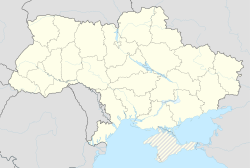Lubny
|
Lubny Лубни |
|||
|---|---|---|---|

Lubny train station
|
|||
|
|||
| Location of Lubny | |||
| Coordinates: 50°01′N 33°00′E / 50.017°N 33.000°ECoordinates: 50°01′N 33°00′E / 50.017°N 33.000°E | |||
| Country |
|
||
| Oblast | Poltava Oblast | ||
| Raion | Lubny Raion | ||
| Founded | 1107 | ||
| Government | |||
| • Mayor | Oleksandr Hrycajenko | ||
| Area | |||
| • Total | 45.6 km2 (17.6 sq mi) | ||
| Elevation | 158 m (518 ft) | ||
| Population (November 2016) | |||
| • Total | 46 287 | ||
| Time zone | EET (UTC+2) | ||
| • Summer (DST) | EET (UTC+3) | ||
| Postal code | 37500 | ||
| Area code(s) | +380 5361 | ||
| Website |
lubny lubinfo |
||
Lubny (Ukrainian: Лубни́) is a city in the Poltava Oblast (province) of central Ukraine. Serving as the administrative center of the Lubny Raion (district), the city itself is also designated as a separate raion within the oblast.
Its estimated population was around 47,101 in 2015.
Lubny is reputed to be one of the oldest cities in Ukraine, allegedly founded in 988 by knyaz (prince) Vladimir the Great (Volodymyr) of Kiev. The first written record, however, dates from 1107.
Initially, it was a small wooden fortress above the Sula River. The fortress quickly grew, and in the 15th or 16th century, it was owned by the powerful Wisniowiecki family. The town was ruled by Magdeburg rights and had a coat of arms.
In 1596, Lubny was the site of the last battle of Severyn Nalyvaiko against the Poles. In the 17th century the city was one of the largest in the area. In 1638 it had 2,646 inhabitants. Between 1648 and 1781, the town was the headquarters of the Lubny Cossack Regiment.
After a railroad line was constructed through Lubny in 1901, industry quickly grew and expanded in the city. During the German occupation in the Second World War, Lubny was the centre of major partisan (resistance) movement. On October 16, 1941 over a thousand of the city's Jews, including women and children, were massacred by German Einsatzgruppen on the outskirts of the city.
...
Wikipedia



